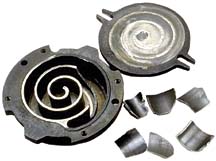
It was a dark and stormy night that dawned to a hot and muggy day. The building, a low-rise commercial structure with retail and office occupants, has a chilled-water cooling system. The primary tenant just moved into the building in January. The carpets and curtains were cleaned, and some redecorating took place - the marble and granite look very nice - but no system maintenance was performed.
The HVAC contractor who previously did work for this building's owner has gone out of business. No further information is available about the company or its owner. No maintenance logs are available for this building's equipment. Based on the appearance of the mechanical room, not much maintenance had been performed in recent history - parts seem to have been replaced. This information was based on the building owner's invoice records.

Trouble Brewing
The first really warm day (upwards of 80 degrees F outside) came in late April, after the passing of that dark and stormy night. The cooling system started up that afternoon when the thermostat called for cooling. The system worked, but deep in the mechanical room, the compressors were running loudly. Nobody heard it; nobody was there. Nothing was seen or heard by the client or the occupants. The ventilation continued to run.In a few hours the stores and offices closed for the day, and the building cooled off overnight, the system having been designed with an economizer. This pattern continued for a few weeks. Nobody paid attention to the air conditioning system because it was working ... apparently.
As the cooling season progressed, the system ran louder and louder; still no one knew about it. The building owner was out of town, and the manager spent most of his time in his office. The electricity bills were getting quite high, but she chalked this up to the air conditioner running and a recent rate increase by the utility. "If this trend continues," she thought to herself, "we will need to find a way to pass the costs along to the tenants."
The cooling season started peaking in late June, with some days approaching 100Þ. One morning the building was warm when the first tenants arrived. They turned their thermostats up and down, depending on their perception of the temperature, not knowing that the stats are dummy stats installed by the previous contractor to stop comfort complaints. The fans were running. The building cooled off during the night, but the next day heated up even earlier. The tenants called the manager.
The manager called a new air conditioning service contractor. "Can you check this out immediately? Some of our tenants are threatening to move out!" The contractor agreed to come out on an emergency basis. It is the pre-July 4 weekend, the legal holiday. "This is going to cost a lot," he warned.
When the service contractor arrived, he quickly found out that the system didn't have any kind of datalogging, no trend reports he could read, and as mentioned, no maintenance logs. He must search for clues where he can find them. First stop: the compressor.

Checking For Clues
First the contractor checked to see if the compressor needed to be replaced. He measured its amp draw. He started the compressor and recorded the suction and discharge pressures, voltage at the terminals, and amperage at the compressor. Then he compared this information to the data on the compressor performance sheet.He knows from experience and ongoing training that a higher-than-normal amp draw could indicate worn compressor components. A lower-than-normal amp draw, on the other hand, would indicate broken components.
Last year one of his customers had a similar system problem and he got a low amp draw reading. First he attempted a pumpdown by closing the suction service valve. This was done to reduce the amount of vapor in the compressor, so he could open it. He watched his pressure gauges; under normal circumstances the suction should have dropped quickly. With broken components, however, it did not.
When he shut the compressor off on that job, he wanted to see if the suction pressure increased, indicating damage to the discharge reeds or gaskets. To confirm this, he removed the heads and valve plates from the compressor and looked for broken valves or rods. Once the valve plates were off, he started looking for broken valves and blown gaskets. He also pushed the piston up and down in the cylinders, looking for a broken rod. All or any of these would result in a lower amp draw.
In the present case, however, the amp draw was high. This got the contractor-detective thinking about something being tight or worn in the compressor, like its bearings or rods. So, he removed the oil pump and the front bearing cover, exposing the end of the crankshaft. With the crankshaft exposed, he checked for excessive bearing wear by moving the crankshaft up and down. Checking for rod wear is more difficult, as it means removing the rods from the crankshaft and making a visual inspection.
He also looked into the compressor's crankcase. He noted the oil level because he might drain the oil from the compressor looking for wear particles from the bearings, rods, crankshaft, etc.
All of this helped confirm whether or not the compressor needed to be replaced. It still doesn't correct the system problem, but now the system can become operational.

What Happened
The culprit in this case is a flooded start. The system went through a one-time pumpdown, then started with liquid in the compressor. Due primarily to a lack of maintenance and a long heating season, there was considerable refrigerant vapor in the crankcase oil.When the compressor started, the diluted oil could not properly lubricate the crankshaft load-bearing surface, causing an erratic wear or seizure pattern.
On closer inspection, he found out that the crankcase heater is no longer working. With the customer's approval, he waited until the next week to look for and find this specific cause. He also found out that the system's air filters have been disregarded completely since they were installed; some were loaded, some are blown through.
Also, some office spaces have been redesigned, affecting the internal airflow patterns.
This insightful service contractor presented the building owner with a detailed invoice, due upon receipt, for the holiday hours and for the regular labor hours for the next week's work. He also presented literature and a video explaining the importance of regular maintenance.
After the repairs were made, he reviewed the electric bills with the owner and manager, showing where the spike in usage occurred when the compressor started to be seriously overworked. He compared the bills to those from the previous year and estimated how much can be saved through regular system maintenance and proactive shutdowns.
Did this contractor get the maintenance contract? How did he correct the problem? Let us hear from you. Please send your replies to barbarachecket-hanks@achrnews.com.
For more information on this topic, visit the Emerson Contractor Connection at www.emersonclimatecontractor.com.
Publication date: 04/19/2004

Report Abusive Comment